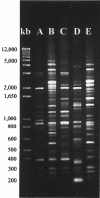Natural acquisition of Helicobacter pylori infection in newborn rhesus macaques
- PMID: 14662932
- PMCID: PMC309038
- DOI: 10.1128/JCM.41.12.5511-5516.2003
Natural acquisition of Helicobacter pylori infection in newborn rhesus macaques
Abstract
Helicobacter pylori infection is usually acquired in childhood, but precise estimates of the age of acquisition are difficult to obtain in young children. Since serial endoscopic biopsies are not feasible in human infants, we examined acquisition of H. pylori infection that is known to occur in socially housed nonhuman primates. By 12 weeks of age, 8 of 20 newborns (40%) were culture positive for H. pylori, and prevalence reached 90% by 1 year of age. Newborns from infected dams were more commonly infected than those from uninfected dams, particularly during the peripartum period, suggesting that close contact during this time may facilitate transmission. Transient infection was uncommon and occurred only after the first positive culture. These results suggest that in a high-prevalence environment, persistent H. pylori infection may be acquired at an earlier age than was previously thought. Since clean, potable water was readily available, contamination of water supply is not essential for widespread infection at an early age in areas where hygiene is otherwise poor. Furthermore, breastfeeding seems to offer little protection, since newborn macaques breastfeed during the first year of life and typically are fully weaned only when another newborn arrives the following spring.
Figures





References
-
- Akada, J. K., K. Ogura, D. Dailidiene, G. Dailide, J. M. Cheverud, and D. E. Berg. 2003. Helicobacter pylori tissue tropism: mouse-colonizing strains can target different gastric niches. Microbiology 149:1901-1909. - PubMed
-
- Ausubel, F. M., R. Brent, R. E. Kingston, D. D. Moore, J. G. Seidman, J. A. Smith, and K. Struhl (ed.). 1990. Current protocols in molecular biology. John Wiley & Sons, Inc., New York, N.Y.
-
- Bardhan, P. K. 1997. Epidemiological features of Helicobacter pylori in developing countries. Clin. Infect. Dis. 25:973-978. - PubMed
-
- Braden, B., H. G. Posselt, P. Ahrens, R. Kitz, C. F. Dietrich, and W. F. Caspary. 2000. New immunoassay in stool provides an accurate noninvasive diagnostic method for Helicobacter pylori screening in children. Pediatrics 106:115-117. - PubMed
-
- Corvaglia, L., P. Bontems, J. M. Devaster, P. Heimann, Y. Glupczynski, E. Keppens, and S. Cadranel. 1999. Accuracy of serology and 13C-urea breath test for detection of Helicobacter pylori in children. Pediatr. Infect. Dis. J. 18:976-979. - PubMed
Publication types
MeSH terms
Grants and funding
LinkOut - more resources
Full Text Sources
Other Literature Sources
Medical

